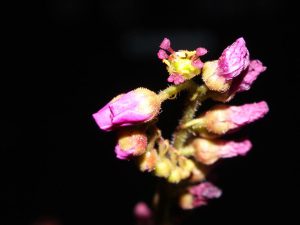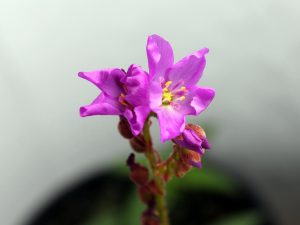First Try Pollinating Drosera capensis
Drosera capensis is one of the carnivores that is able to self pollinate and produces quite a lot of seeds, even when grown indoors. Outdoor plants usually get help with pollination from insects, wind and rain droplets which are absent when you grow plants inside. For successful pollination, pollen from anthers needs to get transferred to stigma. Since there are no pollinators inside, Drosera capensis needs another way to get self pollinated and in the same time, allow and even promote pollination with pollen from nearby droseras.

As it can be seen on the photo on the left, the anthers are much lower than stigmas, which prevents from self pollination while the flower is still closed, but ripe enough for the pollination to occur. Eventually, when flower opens, the filaments that hold the anthers elongate enough for them to get the same height as stigmas, but as long as flower remains open, they remain separated and pollen can’t get transferred. If plants get pollinated while the flower remains opened, the seeds will not be a result of self-pollination but a regular pollination from plants, growing nearby. If there’s no pollination when the petals start closing (Drosera does that quite fast!), the anthers get pushed towards the stigmas and eventually, when the flower closes completely, they all get compressed together in the middle of the closed bloom, efficiently pollinating the flower.

Despite the fact that Drosera capensis simply gets self pollinated, I decided to manually transfer pollen from Drosera capensis ‘Alba’. By pollinating Drosera capensis (typical) with pollen from white version of the plant, I could get seedlings that will be a bit different from the mother plant. By removing the petals I made self pollination unlikely to occur, because the anthers won’t get pushed towards the stigmas as they usually do. I could further make sure to completely prevent self pollination by removing the anthers, but as my goal wasn’t getting hybrids, that wasn’t really necessary. The same method can be used to get hybrids by pollinating different Droseras which have compatible number of chromosomes.
A few months later, after germinating the seeds, I have learned that cross pollination of Alba and typical Drosera capensis most likely failed. Sadly, I never wrote down which pollinated flowers I picked and sown. If it was from typical variety, I may have been extremely successful, but I’m afraid it’s not the case. I think I have sown seed pod of pollinated D. capensis ‘Alba’ and noticed that it only produced white seedlings. It might be, that I was late to apply the pollen or it was just that the ‘white’ gene is dominant over the typical ‘pink’ gene, which I find highly unlikely. I have decided to retry the Alba-typical pollination process again, before trying to make a real cross pollination. The next time, I am going to make sure I cut off all the antlers and wash the pollen that might already be on stigmas using spray bottle. I am also going to use both varieties as mother plant. That way it might be a lot clearer if I actually managed to successfully apply the pollen. If I get all the seedlings identical to mother plant, I’ll know I failed miserably. 🙂